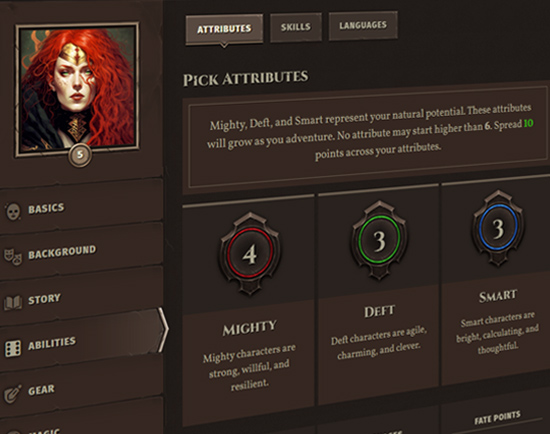The Dice
To play OSR+, all you need is a six-sided die (d6). Ideally, two or more six sided dice (2d6) for the optimal experience. All of the tables in the system are designed with a range of 1 to 6, and all of the rolls entail rolling one or two d6s at most.
It's a good idea to have a full set of polyhedral dice on hand, however, and you can get a set for less than twenty dollars at your local hobby store or online. This will help with any arbitrary rolls the GM might call for at the table.
The Conversation
When you do things in the game, the order in which you declare them matters. There's a cadence to the conversation, and it goes like this:
- You say what you want to do and how you do it.
- The GM figures out if there's a roll involved or not, and if there is, you roll.
- Then the GM says what happens. Rinse, repeat.
Before You Roll
Before the GM resolves your action
You declare any spells or abilities that might alter a roll (unless the spell or ability says otherwise).
After You Roll
The GM uses the core mechanics or may make a ruling in the spirit of the core mechanics to decide your fate.
Rules vs. Rulings
A ruling is the creation of a new rule to resolve action in the game in a way that is not explicitly laid out by the rules-as-written. The GM may make rulings whenever necessary, so long as the ruling doesn't contradict the rules-as-written. (See notes on the fiction for exceptions to this rule.) When making a ruling, the GM's first priority is to be fair, and his second priority is to rule in a way he thinks makes logical sense, given the circumstances of the fiction at the moment of the ruling.
Impossible Rolls
Sometimes it may seem impossible to fail, or impossible to succeed. For example, you need a target number (TN) of 7, but you have an attribute of 6 and a skill that adds +2—it would seem you can't roll below 8. Because of exploding dice and critical failure, it's always possible to succeed or fail. Always roll, even if the numbers say you can't fail.
Critical Success & Exploding Dice
Any time you roll a natural 6 on a d6, the die "explodes": you must roll again and add the result of the second die to your roll. If you succeed on the result, this is considered a critical success. Keep doing this as long as you roll natural 6s.
"Natural" means the die landed on that result and was not modified by other mechanics to equal that result.
The dice do not explode when rolling for initiative or damage, or when confirming a critical failure. Similarly, there is no chance of critical failure for these types of rolls.
Critical Failure
If you roll a 1 on a d6, there is a chance of critical failure. (We sometimes refer to this as “confirming a critical.”) Immediately roll 2d6 to confirm the critical; if you roll snake eyes (both dice turn up 1s), then you have critically failed. Don't bother tallying up your original roll, because even if you would have succeeded, you do not. The GM will decide what mishap occurs that magnifies your failure.
Critical Failure on Exploding Dice
If you roll a 6 (which explodes, so you roll again), and then you roll a 1 on your exploded die, you still need to confirm the critical. If you critically fail on the exploded die, it means you’ve pushed your luck too far: stop rolling and follow the rules for critical failure.
Interpreting Critical Success & Failure
Critical failure and critical success are opportunities for interpretation, both on the part of the GM and the player. There is less than a half a percent chance of critical failure on any given roll, while there’s a ~16% chance of critical success on any given roll. Because the odds of critical failure are so much rarer than critical success, the GM is encouraged to interpret critical failure more dramatically than critical success. Even so, a critical failure should only rarely reflect a hero’s incompetence.
Example of Critical Failure
The sorceress Nyn is confronted with a magical script that locks the dark wizard’s sepulcher. She wants to get inside so she can burn his corpse before he comes back to life!
Nyn: I sit down and break out my tomes. It’s time to decipher this script.
GM: Okay, this script is ancient—unlike anything you’ve seen before. You have plenty of time to do the research since you guys cleared out the tomb’s guardians. Let’s see how well you do. I need an Arcana success check.
Nyn: (rolls d6) Uh oh, that’s a 1!
Nyn doesn’t bother to add her Smart attribute or Arcana skill at this point; she needs to first make sure she didn’t critically fail.
GM: Confirm that critical!
Nyn: (rolls 2d6) … It’s snake eyes.
GM: All right, you spend the next three hours studying the script, referencing your ancient Mamaran texts. You ultimately discover the command word to unseal the sepulcher. The coffin door gives easily… too easily. Mister Loan stands guard with a torch, ready to light the dark wizard’s corpse aflame… but the coffin is empty! You were certain this was his resting place. The script is unmistakable. Then, from somewhere deep within the catacombs… you hear an inhuman cackling!
In this case the GM has decided to interpret critical failure as a radical “misapplication” of Nyn’s methodical approach. The dark wizard already rose from his sepulcher, but this fact has gone unnoticed, putting the party in a tight spot. In many ways, a critical failure has the same impact on the narrative as would a fate point, except it’s employed by the GM against the players. Had Nyn simply failed, he might interpret her misreading of the script as triggering a magical trap placed on the sepulcher instead, as an example.
 Archetypes
Archetypes Armor
Armor Classes
Classes Conflicts
Conflicts Cultures
Cultures Ethos
Ethos Flaws
Flaws Glossary
Glossary Kits
Kits Maleficence
Maleficence Origins
Origins Shields
Shields Skills
Skills Spells
Spells Stances
Stances Status Effects
Status Effects Tactics
Tactics Talents
Talents Techniques
Techniques Treasure
Treasure Weapons
Weapons











 Hall of Heroes
Hall of Heroes Hall of Legends
Hall of Legends



 Dungeons & Flagons
Dungeons & Flagons